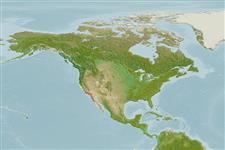>
Perciformes/Zoarcoidei (Eelpouts and pricklebacks) >
Stichaeidae (Pricklebacks) > Xiphisterinae
Etymology: carli: Named in honor of Carl Leavitt Hubbs (1894-1979), twice president of the American Society of Ichthyologists and Herpetologists, friend and mentor, who discovered E. carli and E. laurae..
Environment: milieu / climate zone / depth range / distribution range
Écologie
marin démersal; profondeur 1 - 26 m (Ref. 48788). Subtropical
Eastern Central Pacific: Pacific Grove, California to Bahía San Quintín, Baja California Norte, Mexico.
Taille / Poids / Âge
Maturity: Lm ? range ? - ? cm
Max length : 17.1 cm SL mâle / non sexé; (Ref. 48788)
Description synthétique
Clés d'identification | Morphologie | Morphométrie
Épines dorsales (Total) : 38 - 43; Rayons mous dorsaux (Total) : 19 - 23; Rayons mous anaux: 44 - 49; Vertèbres: 65 - 70. First dorsal spine associated with second pterygiophore; first anal pterygiophore equal in size to second; ventrolateral lateral line connected across breast in an arc that is bisected by a medio ventral lateral line extending from isthmus to fork about anus (Ref. 48788). Caudal fin rounded.
Found on rocky and sandy areas among kelp, in crevices, or kelp holdfasts (Ref. 48788).; subtidal (Ref. 51666).
Life cycle and mating behavior
Maturities | Reproduction | Spawnings | Egg(s) | Fecundities | Larves
Follett, W.I. and M.E. Anderson, 1990. Esselenia, a new genus of pricklebacks (Teleostei: Stichaeidae), with two new species from California and Baja California Norte. Copeia 1990(1):147-163. (Ref. 48788)
Statut dans la liste rouge de l'IUCN (Ref. 130435)
Menace pour l'homme
Harmless
Utilisations par l'homme
Outils
Articles particuliers
Télécharger en XML
Sources Internet
Estimates based on models
Preferred temperature (Ref.
123201): 12.9 - 23.9, mean 17.8 °C (based on 68 cells).
Phylogenetic diversity index (Ref.
82804): PD
50 = 0.7500 [Uniqueness, from 0.5 = low to 2.0 = high].
Bayesian length-weight: a=0.00389 (0.00180 - 0.00842), b=3.12 (2.94 - 3.30), in cm total length, based on all LWR estimates for this body shape (Ref.
93245).
Niveau trophique (Ref.
69278): 2.6 ±0.2 se; based on size and trophs of closest relatives
Résilience (Ref.
120179): Milieu, temps minimum de doublement de population : 1,4 à 4,4 années (Preliminary K or Fecundity.).
Fishing Vulnerability (Ref.
59153): Low vulnerability (11 of 100).
